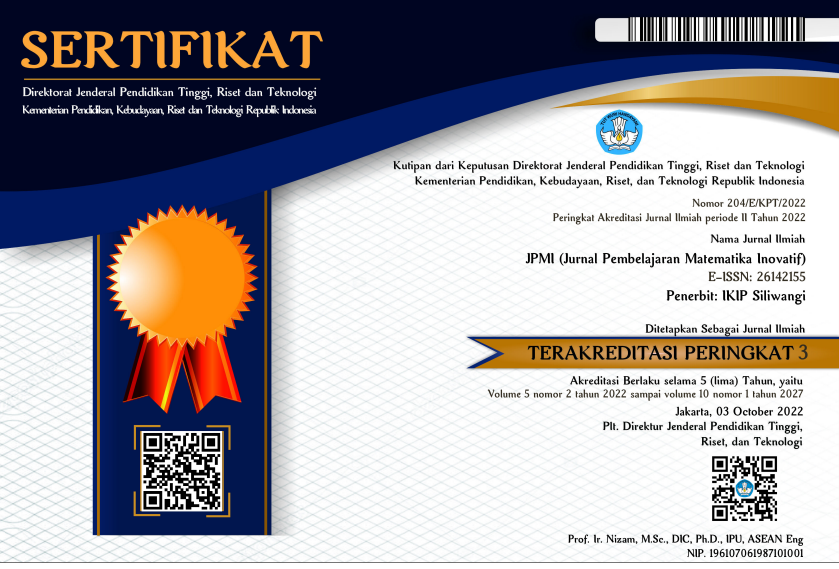ANALISIS KESULITAN MAHASISWA DALAM MENYELESAIKAN MASALAH DISTRIBUSI FREKUENSI PADA MATA KULIAH STATISTIKA DITINJAU DARI KEMAMPUAN KONEKSI MATEMATIS
DOI:
https://doi.org/10.22460/jpmi.v6i3.17309Keywords:
Difficulty analysis, Frequency distribution, Statistics, Mathematical connectionAbstract
References
Haji, S., Abdullah, M. I., Maizora, S., & Yumiati, Y. (2017). Developing Students’ Ability of Mathematical Connection Through Using Outdoor Mathematics Learning. Infinity Journal, 6(1), 11. https://doi.org/10.22460/infinity.v6i1.234
Hidayati, A., Firdaussiah, L., Utami, I. R., Ayu, N. P. (2022). Jurnal Jendela pendidikan. Jendela Edukasi Indonesia, 2(3), 451–458. https://www.ejournal.jendelaedukasi.id/ index.php/JJP/article/view/6
Laili, F. J., & Puspasari, R. (2018). Analisis Kesulitan Belajar Matematika Siswa Ditinjau Dari Kemampuan Koneksi Matematika. JP2M (Jurnal Pendidikan Dan Pembelajaran Matematika), 4(2), 1. https://doi.org/10.29100/jp2m.v4i2.951
Maysani, R., & Pujiastuti, H. (2020). Analisis Kesulitan Mahasiswa Dalam Mata Kuliah Statistika Deskriptif. Al Khawarizmi: Jurnal Pendidikan Dan Pembelajaran Matematika, 4(1), 32. https://doi.org/10.22373/jppm.v4i1.6949
Meifiani, N. I., & Susanto, H. P. (2016). Analisis Kesulitan Mahasiswa Dalam Menyelesaikan Kasus Rancangan Percobaan. Jurnal Derivat: Jurnal Matematika Dan Pendidikan Matematika, 3(2), 68–75. https://doi.org/10.31316/j.derivat.v3i2.718
Rizki, L. M., & Fauziddin, M. (2021). Studi Kasus pada Mahasiswa yang Mengalami Kesulitan Belajar Matakuliah Statistika. Jurnal Pendidikan Tambusai, 5, 11304–11314. https://www.jptam.org/index.php/jptam/article/view/3010%0Ahttps://www.jptam.org/index.php/jptam/article/download/3010/2535
Sugiyono. (2016). Metode Penelitian Kombinasi: Mixed Methods (Sutopo (ed.); Cetakan Ke). Alfa Beta.
Mirawati, Medika, G. H., & Junaidi, J. (2021). Pengaruh Kemampuan Koneksi Matematis Terhadap Kemampuan Pemecahan Masalah Matematis Siswa. Math Educa Journal, 5(1), 54–61. https://ejournal.uinib.ac.id/ jurnal/index.php/matheduca/article/view/1823.

















